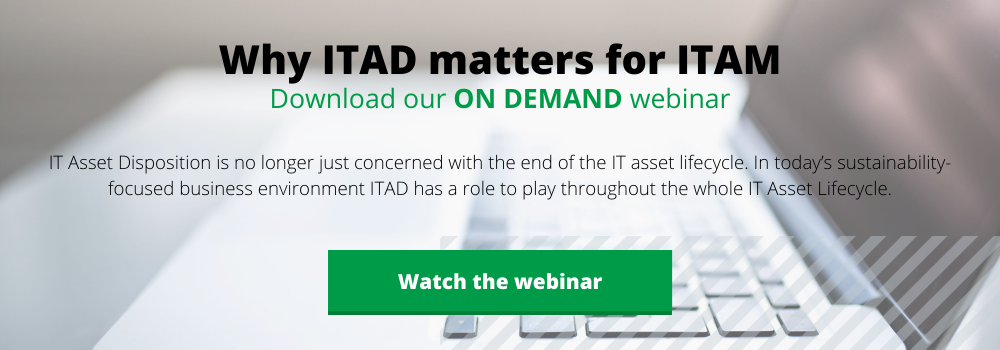Headed by AJ Witt of the ITAM Review and Eric Ingebretsen, TES’ Chief Commercial Officer, this webinar ‘Why ITAD Matters for ITAM’, covers the key strategies that should be used to integrate ITAD into IT governance.
In this blog, we highlight the key insights and talking points AJ and Eric raised.
What is ITAD?
“ITAD is primarily concerned with disposition. But a range of other deliverables and services extends its scope. Secure logistics, stock management and managed deployment group together to help organizations get to grips with managing a remote workforce, for example.” - AJ Witt
The first part of the webinar covers what modern ITAD is. It includes risk management, which has evolved from ensuring compliance with e-waste laws to ensuring the risks of data loss and privacy breaches resulting from improper handling are minimized as well.
AJ also mentions how ITAD focuses on sustainability now. For example, financial and environmental sustainability can be captured through the remarketing of older IT assets.
“What this modern approach to ITAD does is combine operational efficiency, regulatory compliance and sustainability goals together to create a circular economy approach to IT.” A circular economic business model is a key strategy for businesses looking to reduce the environmental impact of their e-waste and create new, advantageous revenue streams from material recycling and asset remarketing.
AJ then covers how we create a circular economy within IT, delving into ‘optimizing consumption’, which is gained through:
- Intelligent sourcing
- Repair and standardization on repairable items
- Sourcing from secondary markets
- Internal redeployment
- Remarking
- Donating
To find out more about creating a circular economy for ICT equipment, read our blog.
Why ITAD matters for ITAM
The webinar answers a key question: ‘“Why should ITAM professionals get involved in ITAD?’ The answer can be broken down into four reasons:
- Engage with new stakeholders
- Find new momentum for your ITAM activity
- Apply risk and cost management skills to a new discipline
- Make a difference to the planet
Similarly, effective ITAD answers several significant questions for ITAM professionals, such as:
- How do we dispose of old equipment?
- When is the best time to do a hardware refresh?
- Are our old devices wiped securely and compliantly?
- Are we complying with local and global regulations?
And compliance is a big focus. “The regulatory environment in the last five years,” begins Eric, “has probably had more movement than the previous fifteen years before that, both in terms of global regulations, the Basel Convention, regional regulations, GDPR, local in-country regulations… it’s all interconnected.”
“It’s this tapestry of regulatory framework that gets very detailed - particularly when you get to the local level. Having someone that is present and understands what these mean in countries that have relationships with local regulatory providers is pretty important.”
Building the ITAD business case
So what’s the business case for ITAD and sustainability? AJ explains that businesses will have to consider:
- Objectives: The business driver the customer wants to address
- Challenges: What’s getting in the way
- Impact: What's the impact of the challenge
Consideration of these leads to actions and deliverables - the ITAD plan for solving the challenges and achieving the objectives. From that, outcomes will be developed. It’s essentially the ROI generated by the actions put in place.
AJ gives a great example: A business looking to improve its sustainability. IT’s challenge is they may not know where devices or peripherals are and have no idea about their remarketing value. The impact of this is devices will sit unused, they won’t be disposed of correctly and there may be excess consumption in the form of net new devices being bought (as IT departments are unsure of how many assets they actually have). The actionable process you can take to remedy this is as follows:
- Integrated ITAD into HAM program
- Track end-of-life dates
- Track remarketing value
- Use this data to inform refresh cycles
So what’s the outcome? AJ states a business can see a reduction in cost and stock, new revenue generated from remarketing and the confirmed compliance with environmental regulations.
Essentially, building the business case relies on utilising visible data to develop ITAD strategies with completely tangible benefits.
Implementing ITAD
“By partnering with an ITAD provider, you can go further. They can help you with the services needed to enable the sustainability journey.”
What’s next when you have secured business backing for ITAD? The following steps involve a series of key strategic actions.
Pre-implementation phase
Pre-implementation involves:
- Setting scopes - Where do responsibilities lie? Who is responsible for the lifecycles of assets? What's the scope of management? How are devices categorized?
- Setting goals - What do you want to achieve? Have you developed vital metrics to follow?
- Assess your regulatory framework - Where is it you operate? What specific laws must your ITAD comply with? (Remember, ITAD providers are strategically placed to help businesses comply with these laws)
- Compile your RFI based on the business case - What are your partner selection criteria?
Selecting your ITAD partner
A crucial part of the webinar covers how you should select an ITAD provider. There are many providers operating today, some who target specific locations and some with a much larger, global reach.
The right ITAD provider can guarantee:
- The right certifications, such as R2, NAID AAA, ISO 9001 and ISO 14001
- Proximity and reach over local, regional and multi-national domains
- A sustainable and compliant destruction focused approach
- Competitive costing
- A completely visible chain of custody
- Integrations with systems such as ServiceDesk, CMDB and ITAM
The first 100 days
So what should the first 100 days look like? First of all, a business must review its current provisions and assess the cross-lifecycle requirements of its assets. Does your business already have an e-waste recycling program in place? How are you destroying sensitive data once an asset is obsolete?
Then there must be a focus on defining the requirements for a provider, which will help select the right ITAD provider. Once you choose this provider, your business can move forward in identifying and reviewing internal ITAD policies, which the ITAD provider can help with.
Finally, within those 100 days, a business must engage the relevant stakeholders, such as IT Ops & service desk. Again, this is something the right ITAD provider can help you with, providing support, feedback and analysis that help develop upon the ITAD business case.
Important takeaways for an ITAD process
The webinar ends with Eric talking through a TES case study, exploring a real-life example of an ITAD provider delivering an efficient ITAD service and securing tangible benefits. At this point, it’s set out what's truly needed for a successful ITAD delivery:
- A global footprint: A provider can reduce the need for subcontractors, guaranteeing a more visible chain of custody, reduced risk of non-compliance and more consistent communication.
- Local support: The ability to solve problems in real-time and work through local regulations, alongside understanding local markets.
- Impacts for the bottom line: The right provider will know how and where to gain the most value when remarketing assets.
- Compliance: Every ITAD process develops risk, especially large, multi-national projects. The right provider will advise on regulations and help organizations stay aware of the dangers.
Watch the webinar today
The webinar states organizations should partner with ITAD providers, building an ITAD business case and apply circular economy concepts to IT operations. However, this is just a summary. This blog has only covered some of the general points and unique insights AJ and Eric bring to the table.
To watch the webinar today and learn more about why ITAD matters for ITAM, alongside how to begin implementing it within your ITAM processes, click the button below.







